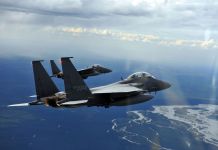The Indian Air Force (IAF) has put obsolete air-to-air missiles (AAM) to good use, turning them into surface-to-air missiles (SAM), if pictures clicked at the latest Defense Expo at Gandhinagar are to be believed.
Russian-origin R-27 and R-73 AAMs have been converted into the SAMAR SAM platform. However, opinion on the system’s viability remains divided among retired IAF fighter pilots.
The R-27 is a medium-range AAM developed during the Cold War by the Soviet Union, an undisclosed number of which India purchased from Ukraine in 2013, according to a report on Air Force Technology.
Russia’s Vympel Design Bureau designs it.
Again, in late July 2019, reports emerged about India purchasing more R-27s worth Rs. 1,500 crores under emergency procurement powers granted to the three services. However, some of the coverage of the July 2019 purchase claimed it was the R-73, hence the procurement could not be verified.
Lovely ?
First clear images of the SAMAR air defence system.
Quite an adaptation!!?? pic.twitter.com/Og3VnEbhX4
— Vayu Aerospace Review (@ReviewVayu) October 17, 2022
This followed the February 2019 air war over Kashmir with the Pakistan Air Force (PAF), when the latter retaliated to India’s air strike at Balakote. That was a reaction to the Pulwama terror strike that killed 44 Central Reserve Police Force (CRPF) personnel.
While ANI News Agency claimed it was the R-27, Zee News and Sputnik said it was the R-73, with the former claiming it was the R-73ER (extended range) variant. The purchase was for the IAF’s frontline Sukhoi Su-30 fighters. The missiles are already used by the IAF’s MiG-21 and MiG-29 fighters.
The R-73 is the missile fired from then Wing Commander (now Group Captain)` Abhinandan’s MiG-21 that shot down the PAF F-16. It has a range of 30 kilometers with an eight-kilogram warhead and an all-aspect infrared passive homing head.
It also has a radar proximity fuse/target sensor. The R-27’s ER and ET variants are the most important models. The ER has a semi-active radar seeker, and the ET has an infrared seeker.
From AAM To SAM
The photo tweeted shows two R-27s mounted on a truck, attached to the rail launchers under fighter aircraft wings. Another few pictures in the following tweet showed a pair of R-73s. A plaque on the turret of the truck that carried the R-27 bore a logo of the IAF, saying it was designed and developed by Simran Flowtech Industries and Yamazuki Denki Pvt Ltd.
Squadron Leader Vijainder Thakur, a retired IAF Jaguar pilot, doubts the arrangement’s effectiveness, primarily pointing to the absence of R-27 production in India.
“Just relying on the current stock would be akin to flogging a dead horse. In any case, it doesn’t look like an operational system. Making it into an operational system would be a waste of the IAF’s budget,” Thakur said.
Even the combat capability would be compromised since the one displayed as being part of the SAMAR is the “variant with an IR seeker” (R-27ET) which “would work like a Man Portable Air Defense (MANPAD) without the easy portability and easy cueing,” Thakur explains. Missiles with IR seekers tend to be most effective when they are ‘locked on to the target before firing.

Group Captain TP Srivastava (Retd), a former MiG-21 pilot, said that information about the guidance and tracking radar is unavailable. “A SAM is only as good as its ground radar,” Srivastava added. Gp Capt Johnson Chacko, who flew Canberra bombers and the MiG-25, said it was not unusual to convert AAMs into SAMs.
He pointed to the US’ Advanced Medium Range Air-to-Air Missile (AMRAAM) being the very missile used in the National Advanced Surface to Air Missile System (NASAMS). “It may be economical to convert such missiles to SAMs. If the acquisition is enabled and the guidance system works, it can be used as a SAM,” Chacko added.
R-27 Was Ukraine’s Handicap
Interestingly, the R-27ER, predominantly available with the Ukrainian Air Force (UAF), was also proving ineffective against Russian Air Force (RuAF) fighters in the initial days of the war, according to a report in Forbes.
The ER has a semi-active radar seeker that works best at or beyond the missile’s maximum range of 96 kilometers. But it is not in the missile but rather a ‘passive radar receiver’ – that needs guidance from the launching fighter’s radar that is bouncing off radar waves from the target.
“If the launching pilot switches off his radar or even turns his jet’s nose away from the enemy, the missile loses the signal…and drifts off-target,” the report said. This requires the launching fighter to close the distance with the target fighter, increasing the chances of it being detected.
Moreover, with its radar switched on, the fighter also gets detected since it is beaming energy. It is akin to locating the enemy in total darkness with a flashlight, but the enemy also sees you by spotting your light.
A Four-Nation ‘Jugaad’ With The R-73
However, the Indian Air Force (IAF) isn’t inexperienced with mating otherwise incompatible systems with technical hacks when one considers the famous project of fusing the Russian R-73 with the French Mirage-2000 with Israeli expertise.
To replace the aging R-530D Magic missiles on the Mirage-2000 in 2008, the IAF had to go against French and Russian objections to integrating the R-73 onto the delta-wing fighter.
In the book ‘Indian Air Force: The Case for Indigenization,’ former Deputy Chief of Air Staff Air Marshal AK Nagalia recalled how Israeli engineers were allowed access to the Mirage-2000’s Digibus. This chipset trades information between the jet’s various sub-systems and its mission computer.
Israeli companies Elbit and Rafael, manufacturers of the DASH helmet-mounted display and Crystal Maze air-to-surface missile (ASM), undertook the project.
An HMD projects flight display, readings, and other information directly on the pilot’s visor. This reduces the stress of flying and focuses more on the combat part.
Lacking the software ‘source codes’ of the Mirage’s radar, the Digibus allowed the Israeli engineers to decode the data bus protocol through “extensive trials.” New algorithms allowed the Mirage’s radar and the Israeli HMD to ‘talk’ to the Russian missile.
- The author can be reached at satamp@gmail.com
- Follow EurAsian Times on Google News




